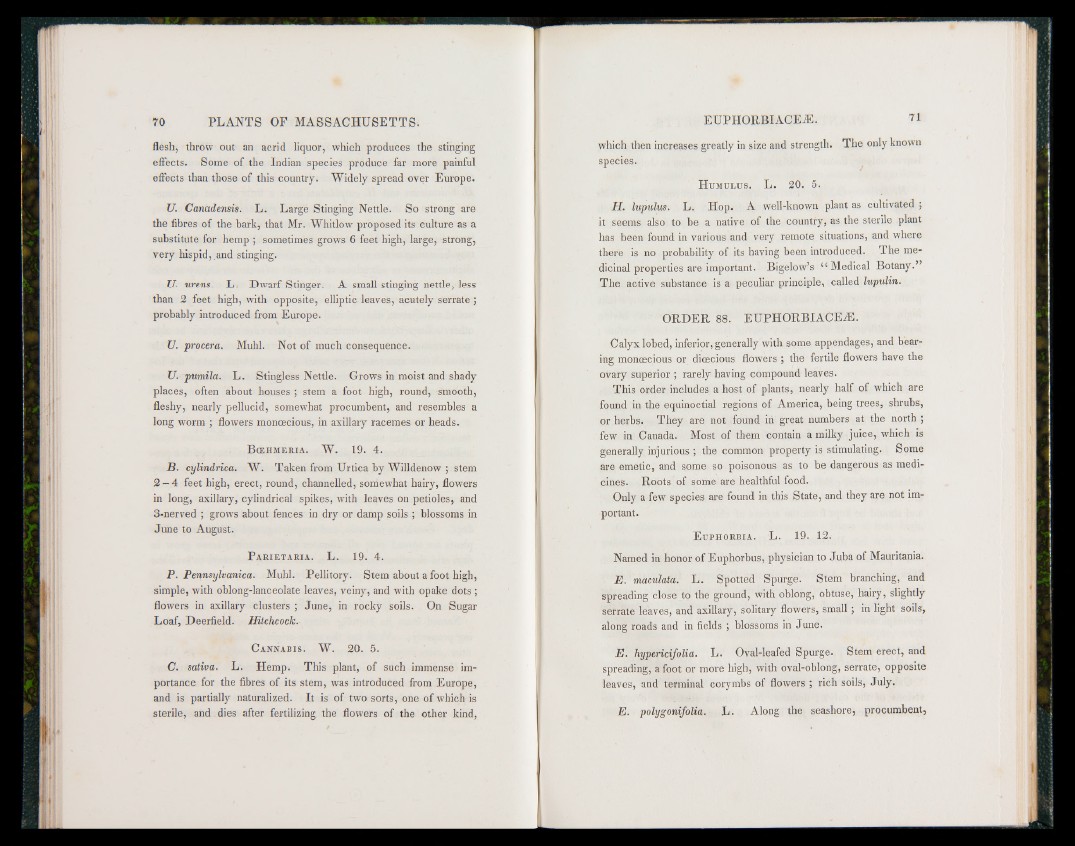
flesh, throw out an acrid liquor, which produces the stinging
effects. Some of the Indian species produce far more painful
effects than those of this country. Widely spread over Europe.
XJ. Canadensis. L. Large Stinging Nettle. So strong are
the fibres of the bark, that Mr. Whitlow proposed its culture as a
substitute for hemp ; sometimes grows 6 feet high, large, strong,
very hispid, and stinging.
U. urens. L. Dwarf Stinger. A small stinging nettle, less
than 2 feet high, with opposite, elliptic leaves, acutely serrate ;
probably introduced from Europe.
XJ. procera. Muhl. Not of much consequence.
U. pumila. L. Stingless Nettle. Grows in moist and shady
places, often about houses; stem a foot high, round, smooth,
fleshy, nearly pellucid, somewhat procumbent, and resembles a
long worm ; flowers monoecious, in axillary racemes or heads.
B cehmeria. W. 19. 4.
B . cylindrica. W. Taken from Urtica by Willdenow ; stem
2 — 4 feet high, erect, round, channelled, somewhat hairy, flowers
in long, axillary, cylindrical spikes, with leaves on petioles, and
3-nerved ; grows about fences in dry or damp soils ; blossoms in
June to August.
P arietaria. L. 19. 4.
P. Pennsylvanica. Muhl. Pellitory. Stem about a foot high,
simple, with oblong-lanceolate leaves, veiny, and with opake dots ;
flowers in axillary clusters ; June, in rocky soils. On Sugar
Loaf, Deerfield. Hitchcock.
Cannabis. W. 20. 5.
C. sativa. L. Hemp. This plant, of such immense importance
for the fibres of its stem, was introduced from Europe,
and is partially naturalized. It is of two sorts, one of which is
sterile, and dies after fertilizing the flowers of the other kind,
which then increases greatly in size and strength. The only known
species.
H umulus. L. 20. 5.
H. lupulus. L. Hop. A well-known plant as cultivated ;
it seems also to be a native of the country, as the sterile plant
has been found in various and very remote situations, and where
there is no probability of its having been introduced. The medicinal
properties are important. Bigelow’s “ Medical Botany.”
The active substance is a peculiar principle, called lupulin.
ORDER 88. EUPH OR B IA CE iE .
Calyx lobed, inferior, generally with some appendages, and bearing
monoecious or dioecious flowers ; the fertile flowers have the
ovary superior ; rarely having compound leaves.
This order includes a host of plants, nearly half of which are
found in the equinoctial regions of America, being trees, shrubs,
or herbs. They are not found in great numbers at the north ;
few in Canada. Most of them contain a milky juice, which is
generally injurious ; the common property is stimulating. Some
are emetic, and some so poisonous as to be dangerous as medicines.
Roots of some are healthful food.
Only a few species are found in this State, and they are not important.
E uphorbia. L. 19. 12.
Named in honor of Euphorbus, physician to Juba of Mauritania.
E . maculata. L. Spotted Spurge. Stem branching, and
spreading close to the ground, with oblong, obtuse, hairy, slightly
serrate leaves, and axillary, solitary flowers, small ; in light soils,
along roads and in fields ; blossoms in June.
E . hypericifolia. L. Oval-leafed Spurge. Stem erect, and
spreading, a foot or more high, with oval-oblong, serrate, opposite
leaves, and terminal corymbs of flowers ; rich soils, July.
E. polygonifolia. L. Along the seashore, procumbent,